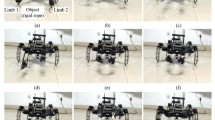Abstract
A new lightweight six-legged robot that uses a simple mechanism and can move and work with high efficiency has been developed. This robot consists of two leg-bases with three legs each, and walks by moving each leg-base alternately. These leg-bases are connected to each other with a 6 degrees of freedom (DOF) mechanism. While designing this robot, the output force, velocity, and workspace of various connection mechanisms were compared, and the results showed that good performance could be achieved with a serial/parallel hybrid mechanism. The serial/parallel hybrid mechanism consists of three 6-DOF serially linked arms positioned with radial symmetry about the center of each leg-base; each leg-base is composed of two active and four passive joints. Walking experiments with this robot confirmed that this mechanism has satisfactory performance not only as a walking robot, but also as an active walking platform. Furthermore, in this robot, the entire leg-drive mechanism acts as a 6-axis force sensor, and individual sensors at the feet are not necessary. The forces and moments can be calculated from the changes in the joint angles. Experiments conducted verified that smooth contact with the ground by the swing-leg and successful switching from swing to support leg can be achieved using this force control and force measurement method.
Similar content being viewed by others
References
Fukuda, T., Adachi, Y., Hoshino, H., Matsunaga, I., and Arai, F. 1995. An omni-directional six-legged walking robot. Advanced Robotics, 9(2):177–191.
Gorinevsky, D.M. and Shneider, A.Y. 1990. Force control in locomotion of legged vehicles over rigid and soft surfaces. International Journal Robotics Research, 9(2):4–23.
Hamlin, G.J. and Sanderson, A.C. 1996. TETROBOT modular robotics: Prototype and experiments. In Proc. of the IEEE/RSJ International Conference on Intelligent Robots and Systems, pp. 390–395.
Hirose, S., Homma, K., Matsuzawa, S., and Hayakawa, S. 1992. Parallel link walking vehicle and its basic experiments. In Proc. of the 6th Symposium on Intelligent Mobile Robots, pp. 7–8 (in Japanese).
Kaneko, M., Abe, M., and Tachi, S. 1984. Basic considerations on degrees of freedom of multi-legged locomotion machines. JRSJ, 2(2):58–66 (in Japanese).
Klein, C.A. and Kittivatcharpong, S. 1990. Optimal force distribution for the legs of a walking machine with friction cone constraints. IEEE International Journal of Robotics and Automation, 6(1): 73–85.
Koyachi, N., Adachi, H., and Nakano, E. 1990. Terrain following control of self-contained semi-fixed gait hexapod walking robot. In Proc. of the IEEE/RSJ International Conference on Intelligent Robots and Systems, pp. 309–314.
Krishn, M., Bares, J., and Mutschler, Ed. 1997. Tethering system design for Dante II. In Proc. of the IEEE International Conference on Robotics and Automation, pp. 1100–1105.
Ota, Y., Inagaki, Y., Yoneda, K., and Hirose, S. 1998. Research on a six-legged walking robot with parallel mechanism. In Proc. of the IEEE/RSJ International Conference on Intelligent Robots and Systems, Victoria, B.C., Canada, pp. 241–248.
Ota, Y., Yoneda, K., Ito, F., and Hirose, S. 1999. Design concept for a walking machine with reduced degree of freedom. In Proc. of 2nd International Workshop and Conference on Climbing and Walking Robots, Portsmouth, U.K., pp. 485–496.
Ota, Y., Yoneda, K., Hirose, S., and Ito, F. 1999. Six-axis force control for walking robot with serial/parallel hybrid mechanism. In Proc. of the IEEE International Conference on Robotics and Automation, Detroit, MI, USA, pp. 1469–1474.
Pai, D.K., Barman, R.A., and Ralph, S.K. 1994. Platonic beasts: A new family of multilimbed robots. In Proc. of the IEEE International Conference on Robotics and Automation, pp. 1019–1025.
Pierrot, F., Uchiyama, M., Dauchez, P., and Fournier, A. 1990. A new design of a 6-DOF parallel robot. Journal of Robotics and Mechatronics, 2(4):308–315.
Stewart, D. 1965–1966. A platform with six degrees of freedom. In Proceeding of the Institute of Mechanical Engineers, 180-I(15):371–386.
Tsumaki, T. 1993. Development of practical hexapod walking robot. In JRSJ Conference on Robotics and Mechatronics, 93-(4):336–339, (in Japanese).
Waldron, K.J. 1986. Force and motion control in legged locomotion. IEEE Journal of Robotics and Automation, RA-2(4).
Yoneda, K. and Hirose, S. 1992. Dynamic and static fusion gait of quadruped walking vehicle on winding path, In Proc. of the IEEE International Conference on Robotics and Automation, pp. 143–148.
Yoneda, K., Iiyama, H., and Hirose, S. 1994. Sky-hook suspension control of a quadruped walking vehicle. In Proc. of the IEEE International Conference on Robotics and Automation, pp. 999–1004.
Author information
Authors and Affiliations
Rights and permissions
About this article
Cite this article
Ota, Y., Yoneda, K., Ito, F. et al. Design and Control of 6-DOF Mechanism for Twin-Frame Mobile Robot. Autonomous Robots 10, 297–316 (2001). https://doi.org/10.1023/A:1011287810340
Issue Date:
DOI: https://doi.org/10.1023/A:1011287810340




